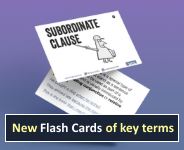Restrictive and non-restrictive relative clauses
In this lesson, we look at the difference between two kinds of relative clause. A relative clause is a special kind of subordinate clause, and like other subordinate clauses it is introduced by a subordinating conjunction. More specifically, the introduction of a relative clause can be carried out by a relative pronoun.
The two types of relative clauses we will be looking at are:
Welcome back!

Englicious is totally free for everyone to use!
But you will have to log in to see our library of teaching resources.
If you don’t have an account, that’s perfectly OK. You can register (for free).
It only takes a minute or two.
»
- Printer-friendly version
- Log in to view or leave comments

